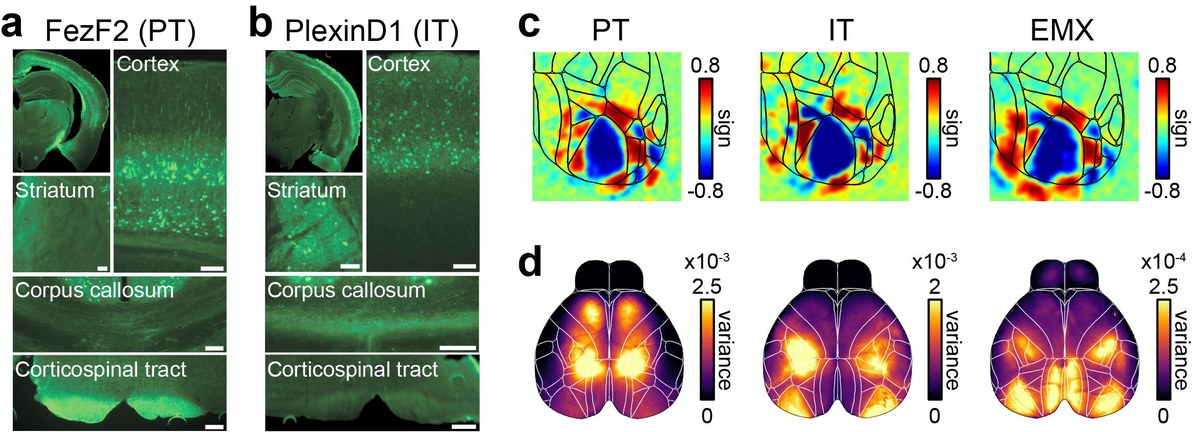Pyramidal cell types drive functionally distinct cortical activity patterns during decision-making
S. Musall, X.R. Sun, H. Mohan et al. Nature Neuroscience (2023). https://doi.org/10.1038/s41593-022-01245-9
In the paper published in Nature Neuroscience our colleague Simon Musall and researchers at RWTH Aachen University, Cold Spring Harbor Laboratory and other institutes in the United States closely examined the functions of different pyramidal cells, which are commonly found in the human cortex (s. Medical Xpress article for add. information).
A major goal in neuroscience is to understand how living neural networks process information and generate complex behavior. However, neural circuits are comprised of various cell types with different connection patterns and potentially very diverse functional roles. To gain a deeper understanding of the function of neural circuits, therefore, requires investigating the various cell types that comprise them. A particularly important factor for neural computations could be the specialized function of different types of excitatory pyramidal neurons, which form far-reaching connections that allow the flow of information between different brain areas. The function of these different neuron types is currently not well understood and it also remains unclear if functional differences between cell types are a general theme of brain function or rather depend on specific brain regions.
To address these questions we used genetic and anatomical labeling to specifically target different types of pyramidal neurons: pyramidal tract (PT), intratelencephalic (IT), and corticostriatal projection neurons. We then used functional imaging to measure the activity of each neuron type throughout the entire cortex of awake mice that performed a perceptual task. Each cell type drove unique neural dynamics, both at the local and cortex-wide scale, demonstrating a surprising functional diversity across cell types that were found across all brain regions (Fig. 1). To test if these functional differences also causally influenced different brain functions, such as the perception of sensory information or generation of behavior, we used targeted optogenetic inactivation to disrupt the function of each cell type in task-performing animals. These inactivations confirmed our imaging results and showed that each cell type served distinct functional roles: all cell types in the parietal cortex were recruited during the perception of the sensory stimulus, but, surprisingly, PT neurons had the largest causal role. In the frontal cortex, all cell types were required for the generation of accurate behavior but showed distinct choice-tuning. Our results reveal that different cell types across the cortex exhibit rich neural dynamics that shape perceptual decisions and represent the functional building blocks that underly brain-wide computations.
FIGURE 1. Knock-in mouse lines enable pyramidal neuron subtype-specific recordings of cortex-wide neural activity. a) Expression of a fluorescent calcium indicator in PT neurons. Cortical labeling is largely confined to layer 5b. Axonal projections were found in multiple subcortical regions such as the striatum and the corticospinal tract. Scale bars, 100 μm. b) Expression of a fluorescent calcium indicator in IT neurons is widespread throughout the cortex and restricted to superficial layers 2/3 and layer 5a. Axonal projections were found in the striatum and corpus callosum but were absent in the corticospinal tract. c) Visual sign maps from neural responses in retinotopic mapping experiments. IT and PT populations showed clear retinotopic responses in primary and secondary visual areas (black lines) where boundaries largely resembled known areas from non-cell-type-specific imaging (EMX). d) Cortex-wide maps of total variance maps from the same mice as in c, showing most modulated cortical regions in each PyN type.
Publications: 1. Musall, S., Sun, X.R., Mohan, H. et al. Pyramidal cell types drive functionally distinct cortical activity patterns during decision-making. Nat Neurosci (2023). https://doi.org/10.1038/s41593-022-01245-9
2. Study shows that distinct pyramidal cell types drive different patterns of cortical activity during decision-making - by Ingrid Fadelli, Medical Xpress, February 20, 2023.
Contact:
J. Prof., Dr. SIMON MUSALL
Institute of Biological Information Processing-Bioelectronics (IBI-3)
Tel.: +49 2461 61-3539
E-Mail: s.musall@fz-juelich.de

